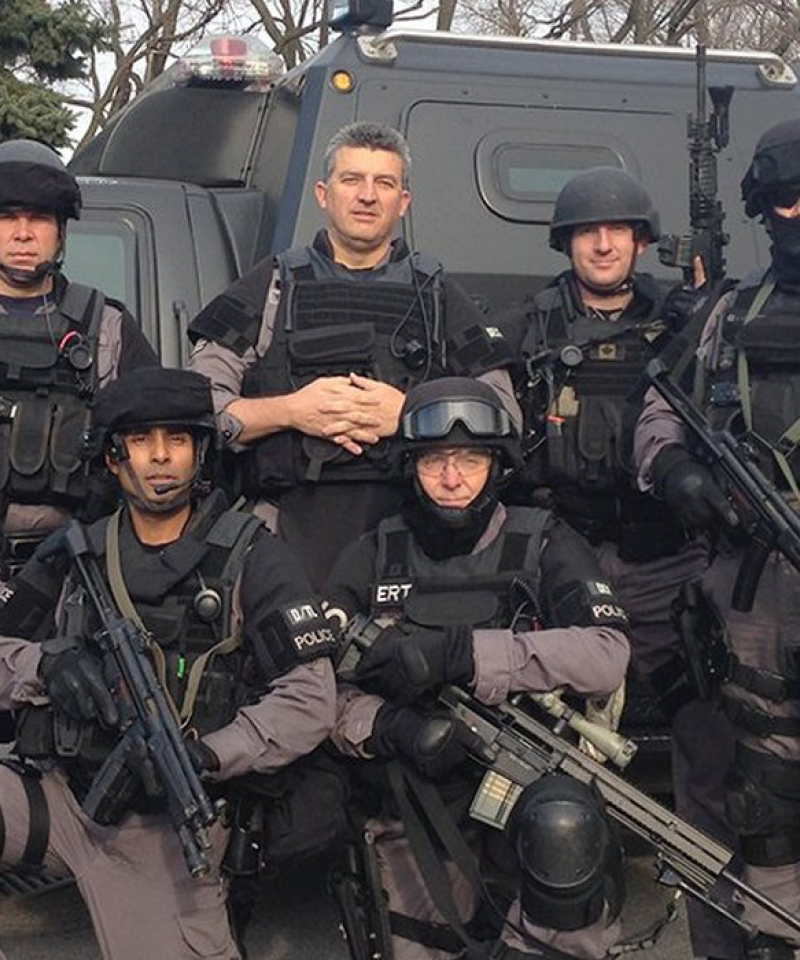Canada

Abolish C-IRG (https://abolishcirg.org/about) is campaigning to close the Community-Industry Response Group, a unit they accuse of using "intimidation, torture, brutality, harassment, racism, theft, destruction of property, arbitrary detention, inhumanity, lying and deceit to suppress the voices of people on the land standing up for Indigenous rights and environmental issues."
Research undertaken in 2018 on the use of SWAT teams in Canada identified a significant rise in the use of such units. The research found that in 1980, Canadian SWAT teams were deployed roughly 60 times a year – now the number is 1,300 times, an increase of 2,100%. The researchers argued that the use of SWAT teams was “normalized”, and that they were regularly engaging in “routine areas of policing”.
Other analysts have argued that “Most people would struggle to distinguish the Toronto Police’s ETF [Emergency Task Froce] from a military unit” after undertaking research which compares the equipment used by the Toronto ETF with that of military units.
Indigenous communities in Canada experience militarised policing at the hands of the Royal Canadian Mounted Police, especially when trying to resist extractivist projects. For example, the Wet’suwet’en nation have regularly faced raids of their community spaces on their territory, because of their resistance to the construction of the Coastal Gaslink Pipeline.
The Royal Canadian Mounted Police
The Royal Canadian Mountain Police was formed in 1873, and called the North West Mounted Rifles in 1920, when they also absorbed the Dominion Police. Their mandate has always been to protect the crown and its interests, responsible for clearing indigenous communities off land to make way for settlers and enforcing the Indian Act against indigenous people.
The force now employs around 30,000 people, and have been regularly involved in violent incidents, including militarised raids on the lands of indiengous communities. For example, when discussing how to conduct a raid on the Wet’suwet’en’s lands, commanders argued the need for “lethal overwatch”, a term for an officer designated to use lethal force. The operation planned to remove the Gidimt’en checkpoint in December 2018. Officers were also told to “use as much violence towards the gate as you want”. The raid was conducted by members of the RCMP wearing green fatigues and military-style weapons. Helicopters and river boats were also used. 14 people were arrested in the raid.
The moment RCMP came over the gates and started making arrests to enforce the Coastal GasLink injunction. pic.twitter.com/n6Cy1RLUu4
— ChantelleBellrichard (@pieglue) January 8, 2019
Community-Industry Response Group
The C-IRG was formed in 2017 to provide, according to the RCMP “strategic oversight adressing industry incidents and related public order, national security and crime issues” across British Columbia. More specifically confidential documents describe C-IRG formation “in response to large scale resource based industrial operations scheduled in British Columbia”.
The C-IRG is made up of various components with specific roles and functions. For example, the Quick Response Team provides a surge capacity and receive training in “of quads, snow machines, watercraft, operational planning and protest management”, while the Emergency Response Team is trained in the use of weapons and other skills, including breaching blockades.
As well as the violence experienced by the Wet’suwet’en, other indigenous groups have been targetted due to their opposition to extractivist projects. The Tiny House Warriors village were established in 2017 following a traditional Secwepemc assembly, which declared its opposition to the Trans Mountain expansion. The project would add an additional pipeline to the Trans Mountain Pipeline, which currently carries 300,000 barrels of tar sands diluted bitumen every day. The expansion would increase the capacity to 890,000.